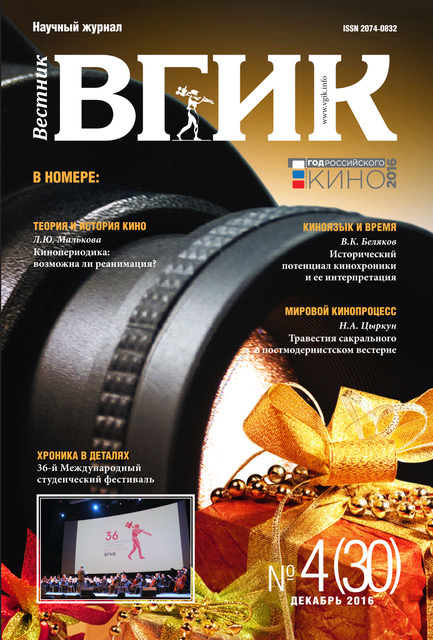Traits of Mystery (miracle play), Tragedy and Commedia Dell'Arte in a Fairy-Opera-Film
- Authors: Kropova D.S1
-
Affiliations:
- ВГИК
- Issue: Vol 8, No 4 (2016)
- Pages: 76-83
- Section: PERFORMANCE | ART OF PRESENTATION
- URL: https://journals.eco-vector.com/2074-0832/article/view/14680
- DOI: https://doi.org/10.17816/VGIK8476-83
- ID: 14680
Cite item
Full Text
Abstract
This article deals with a fairy-opera-film and its specifics. The author reveals traits of mystery (miracle play) in a fairy-opera-film, basing upon a notion of mystery of Carl Orff’s theory, in the way as Orff meant it. Syncretism in different kinds of art, specifics of word as an art facility (meaning of a word and a word as sound) are specified. As examples the following films are taken: Bluebeard's Castle (composer Bela Bartok, filmmaker W. Golovin,1968), Iolanta (composer Pyotr Tchaikovsky, filmmaker W. Gorriker,1963) and animated musical The Snow Maiden (composer Nikolai Rimsky-Korsakov, filmmaker I. Ivanow-Vano,1952). Special attention is drawn to the opera film The Queen of Spades (composer Pyotr Tchaikovsky, filmmaker R. Tihomirov,1960). The author discloses in fairy-opera-film elements of commedia dell'arte, that is improvisation and masks. For example in films The Love for three Oranges (composer Sergei Prokofiev, filmmakers W. Titov and J. Bogatyrenko,1970) and The Magic Flute (composer Wolfgang A. Mozart, filmmaker I. Bergman,1975). The author comes to the conclusion concerning the targets and tasks of a fairy-opera-film. Through watching fairy-opera-films children should live cultural and psychological history of humanity step by step in its development through music, dance culture and drama (theater). The main task of fairy-opera-film is to save an entity of a human being, to prevent a child’s mutation into either a superman (or “Übermensch” in F. Nietzsche’s term) or degeneration.
Keywords
About the authors
Daria S Kropova
ВГИК
Author for correspondence.
Email: editor@vestnik-vgik.com
Post-Graduate student, VGIK.
References
- О специфике кинооперы статью «От древнегреческой трагедии к киноопере» // Вестник ВГИК, 2015, № 2 (24). С. 62-73
- О родстве сказки и мифа см. Пропп В. Русская сказка. М.: Лабиринт, 2000. С. 34-35
- Orff C. Schulwerk Musik für Kinder. In 6 Bd. Mainz: Schott, Cop. 1950-1977
- Барток Б. Сборник статей. - М.: Музыка, 1977. - 262 с.
- Дживеленгов А.К. Итальянская народная комедия. Искусство итальянского Возрождения. - М.: ГИТИС, 2015. - 552 с.
- Кропова Д.С. От древнегреческой трагедии к киноопере // Вестник ВГИК, 2015, № 2 (24). - С. 62-72.
- Леонтьева О.Т. Книга о Карле Орфе. - М.: Композитор, 2010. - 512 с.
- Пропп В.Я. Морфология волшебной сказки. - М.: Лабиринт, 2003. - 143 с.
- Эмихен Г. Греческий и римский театр. - М.: ЛИБРОКОМ, 2012. - 312 с.
- Леонтьева О. Карл Орф. М.: Музыка, 1964. С. 126-142
- Чайковский П. Пиковая дама. М.: Большой театр, 2015. С. 123
- Лотман Ю. «Пиковая дама» и тема карт и карточной игры в русской литературе начала XIX в. // Избранные статьи в трех томах. Т. 2. Таллин: Александра, 1992. С. 389-415
- Фрейденберг О. Целевая установка коллективной работы над сюжетом о Тристане и Изольде. Воспоминания о Марре // Сумерки лингвистики: из истории отечественного языкознания. Антология. М.: Academia, 2001. С. 327
Supplementary files








